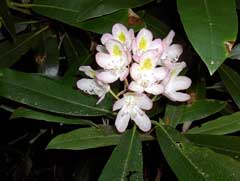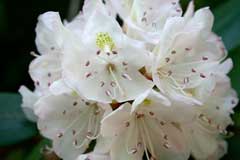 |
|
http://www.flickr.com/photos/28340342@N08 |
 |
| http://commons.wikimedia.org/wiki/User:SB_Johnny |
Translate this page:
Summary
Physical Characteristics

 Rhododendron maximum is an evergreen Shrub growing to 3.5 m (11ft 6in).
Rhododendron maximum is an evergreen Shrub growing to 3.5 m (11ft 6in).
See above for USDA hardiness. It is hardy to UK zone 3. It is in leaf all year, in flower from June to July, and the seeds ripen in October. The species is hermaphrodite (has both male and female organs) and is pollinated by Bees.
Suitable for: light (sandy) and medium (loamy) soils and prefers well-drained soil. Suitable pH: mildly acid soils and can grow in very acid soils.
It can grow in semi-shade (light woodland). It prefers moist soil.
UK Hardiness Map
US Hardiness Map
Synonyms
R. procerum.
Habitats
Woodland Garden Dappled Shade; Shady Edge;
Edible Uses
References More on Edible Uses
Medicinal Uses
Plants For A Future can not take any responsibility for any adverse effects from the use of plants. Always seek advice from a professional before using a plant medicinally.
Analgesic Antirheumatic Cardiac
The poulticed leaves are used to relieve arthritic pain, headaches etc[61, 222]. A decoction of the leaves is occasionally employed internally in domestic practice in the treatment of rheumatism[82, 257]. The leaves are taken internally in controlled dosage for the treatment of heart ailments[222]. Caution is advised, see the notes above on toxicity.
References More on Medicinal Uses
Now available: PLANTS FOR YOUR FOOD FOREST: 500 Plants for Temperate Food Forests and Permaculture Gardens.
An important new book from PFAF. It focuses on the attributes of plants suitable for food forests, what each can contribute to a food forest ecosystem, including carbon sequestration, and the kinds of foods they yield. The book suggests that community and small-scale food forests can provide a real alternative to intensive industrialised agriculture, and help to combat the many inter-related environmental crises that threaten the very future of life on Earth.
Read More
Other Uses
Wood
Wood - fine-grained, hard, heavy, strong, rather brittle[46, 61, 82, 229]. It weighs 39lb per cubic foot[235]. Used for tool handles and as a boxwood (Buxus spp.) substitute in engraving[46, 61, 82, 229].
Special Uses
References More on Other Uses
Cultivation details
Succeeds in a most humus-rich lime-free soils except those of a dry arid nature or those that are heavy or clayey[1]. Prefers a peaty or well-drained sandy loam[1]. Succeeds in sun or shade, the warmer the climate the more shade a plant requires[200]. A pH between 4.5 and 5.5 is ideal[1]. Hardy to about -30°c[184]. Succeeds in a woodland though, because of its surface-rooting habit[200], it does not compete well with surface-rooting trees[1]. Plants need to be kept well weeded, they dislike other plants growing over or into their root system, in particular they grow badly with ground cover plants, herbaceous plants and heathers[200]. Plants form a root ball and are very tolerant of being transplanted, even when quite large, so long as the root ball is kept intact[200]. Plants in this genus are notably susceptible to honey fungus[200].
References Carbon Farming Information and Carbon Sequestration Information
Temperature Converter
Type a value in the Celsius field to convert the value to Fahrenheit:
Fahrenheit:
The PFAF Bookshop
Plants For A Future have a number of books available in paperback and digital form. Book titles include Edible Plants, Edible Perennials, Edible Trees, and Woodland Gardening. Our new book to be released soon is Edible Shrubs.
Shop Now
Propagation
Seed - best sown in a greenhouse as soon as it is ripe in the autumn and given artificial light. Alternatively sow the seed in a lightly shaded part of the warm greenhouse in late winter or in a cold greenhouse in April. Surface-sow the seed and do not allow the compost to become dry[200]. Pot up the seedlings when they are large enough to handle and grow on in a greenhouse for at least the first winter. Layering in late July. Takes 15 - 24 months[78]. Cuttings of half-ripe wood, August in a frame. Difficult[78].
Other Names
If available other names are mentioned here
Native Plant Search
Search over 900 plants ideal for food forests and permaculture gardens. Filter to search native plants to your area. The plants selected are the plants in our book 'Plants For Your Food Forest: 500 Plants for Temperate Food Forests and Permaculture Gardens, as well as plants chosen for our forthcoming related books for Tropical/Hot Wet Climates and Mediterranean/Hot Dry Climates. Native Plant Search
Found In
Countries where the plant has been found are listed here if the information is available
Weed Potential
Right plant wrong place. We are currently updating this section.
Please note that a plant may be invasive in one area but may not in your area so it’s worth checking.
Conservation Status
IUCN Red List of Threatened Plants Status :

Growth: S = slow M = medium F = fast. Soil: L = light (sandy) M = medium H = heavy (clay). pH: A = acid N = neutral B = basic (alkaline). Shade: F = full shade S = semi-shade N = no shade. Moisture: D = dry M = Moist We = wet Wa = water.

Expert comment
Author
L.
Botanical References
1143200
Links / References
For a list of references used on this page please go here
Readers comment
© 2010, Plants For A Future. Plants For A Future is a charitable company limited by guarantee, registered in England and Wales. Charity No. 1057719, Company No. 3204567.